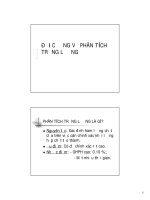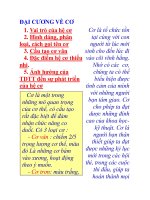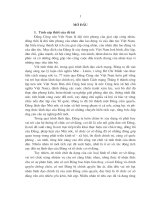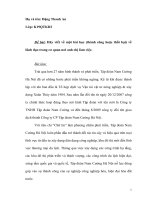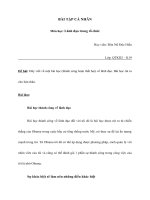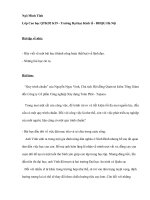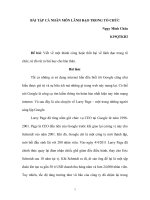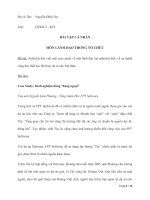Đại cương về lãnh đạo trong tổ chức chapter 4 leadership and influence
Bạn đang xem bản rút gọn của tài liệu. Xem và tải ngay bản đầy đủ của tài liệu tại đây (1.07 MB, 38 trang )
.c
om
an
co
ng
Chapter 4
cu
u
du
o
ng
th
Influencing: Power, Politics,
Networking, and
Negotiation
Copyright © 2010 by South-Western/Cengage Learning
All rights reserved.
CuuDuongThanCong.com
PowerPoint Presentation by Rhonda S. Palladi
Georgia State University
/>
.c
om
Leadership and Influence
Leadership
ng
Influencing
th
an
co
ng
Is the “influencing” process of leaders
and followers to achieve organizational
objectives through change
cu
u
du
o
Is the process of affecting others’
attitudes and behavior in order to
achieve an objective
2
CuuDuongThanCong.com
/>
.c
om
Influencing Tactics
Inspirational
appeal
co
ng
Rational
persuasion
Consultation
an
Pressure
ng
th
Influencing
Tactics
u
du
o
Legitimization
Ingratiation
cu
Personal
appeal
Coalitions
Exchange
Source: Adapted from J. French and B. H. Raven. 1959. “The Bases of Social Power.” In Studies of Social Power,
D. Cartwright, ed. Ann Arbor, MI: Institute for Social Research
CuuDuongThanCong.com
/>
3
.c
om
Power
cu
u
du
o
ng
th
an
co
ng
Is the leader’s potential influence over
followers
Often does not have to be used to
influence followers (I disagree; most of
the times, power has to be used to
influence people)
Used to get people to do what they
otherwise would not do
4
CuuDuongThanCong.com
/>
co
ng
.c
om
Discussion Question #1
cu
u
du
o
ng
th
an
Is power good or bad for
organizations?
5
CuuDuongThanCong.com
/>
.c
om
Power (cont.)
cu
u
du
o
ng
th
an
co
ng
Can be seen as negative and
manipulative
Power within organizations should be
viewed in a positive sense
Without power, organizational objectives
cannot be achieved
Required for leadership
6
CuuDuongThanCong.com
/>
co
ng
.c
om
Sources of Power
du
o
ng
th
an
Position
Derived from
top
management
cu
u
Personal
Derived from the
followers based
on leader’s behavior
7
CuuDuongThanCong.com
/>
.c
om
Position Power
cu
u
du
o
ng
th
an
co
ng
Is derived from top management
Is delegated down the chain of command
Results from holding a management
position
8
CuuDuongThanCong.com
/>
.c
om
Personal Power
cu
u
du
o
ng
th
an
co
ng
Is derived from the followers
Is based on the leader’s behavior
Followers can have personal power over
leaders
A manager should have both personal
power and position power
9
CuuDuongThanCong.com
/>
.c
om
Types of Power
Legitimate power
cu
u
du
o
ng
th
an
co
ng
Is based on the user’s position power, given
by the organization
Employees agree to comply with
management authority in return for the
benefits of membership
Most day-to-day manager–employee
interactions are based on legitimate power
10
CuuDuongThanCong.com
/>
.c
om
Types of Power (cont.)
To increase legitimate power:
du
o
Explain the need for the objective
Explain how others will benefit
Provide evidence that the objective can be met
Explain potential problems and their handling
Explain why your plan is better than others
u
–
–
–
–
–
ng
th
an
co
ng
Get management experience
Work to gain the perception of power
Exercise your authority regularly
Use rational persuasion
cu
Back up your authority with rewards and
punishment
CuuDuongThanCong.com
/>
11
.c
om
Types of Power (cont.)
Reward power
cu
u
du
o
ng
th
an
co
ng
Is based on the user’s ability to influence
others with something of value to them
Impacts performance expectations and
achievement
A leader’s power is strong or weak based on
his or her ability to reward and punish
Uses the exchange influence tactic
12
CuuDuongThanCong.com
/>
.c
om
Types of Power (cont.)
To increase reward power:
cu
u
du
o
ng
th
an
co
ng
Have control over employee evaluations,
raises, promotions, etc.
Find out what others value, and use it to
reward them
Let people know you control rewards, and
state your criteria for receiving them
13
CuuDuongThanCong.com
/>
.c
om
Types of Power (cont.)
Coercive power
cu
u
du
o
ng
th
an
co
ng
Involves punishment and withholding of
rewards to influence employee compliance
Uses the pressure influencing tactic
Often used by peers to enforce norms
Used to maintain discipline and enforce rules
Without it, employees may ignore the leader
Overuse undermines the leader’s authority
and creates hostile opposition
Has generally been declining as an influence
technique
14
CuuDuongThanCong.com
/>
.c
om
Types of Power (cont.)
To increase coercive power:
co
ng
Gain authority to use punishment and
withhold rewards
th
an
– Make sure employees know the rules and penalties
– Remain calm and encourage improvement
ng
Do not make rash threats
du
o
– Do not use coercion to manipulate others or gain
personal benefits
cu
u
Be persistent, set deadlines, and check
progress often
15
CuuDuongThanCong.com
/>
.c
om
Types of Power (cont.)
Referent power
cu
u
du
o
ng
th
an
co
ng
Is based on the user’s personal relationships
with others
Uses the personal appeals and inspirational
appeals influencing tactics
Stem primarily from friendship, or the
employee’s attractiveness to the person
using power
Being liked or the desire to be liked gives
referent power
Is appropriate for people with weak, or no,
position power, such as with peers
16
CuuDuongThanCong.com
/>
.c
om
Types of Power (cont.)
Develop people skills
ng
To increase referent power:
an
co
– Remember that not only managers have referent
power
cu
u
du
o
ng
th
Work at having good relationships with
managers, peers, and subordinates
17
CuuDuongThanCong.com
/>
.c
om
Types of Power (cont.)
Expert power
cu
u
du
o
ng
th
an
co
ng
Is based on the user’s skill and knowledge
Makes others dependent on the person with
the power
Can be a factor of personal power
Can lead to promotion into management
People respect experts
Uses rational persuasion
18
CuuDuongThanCong.com
/>
.c
om
Types of Power (cont.)
To increase expert power:
an
co
ng
Take training and educational programs
Attend trade or professional association
meetings and programs
ng
th
– Read professional and trade journals
– Get published in professional journals
cu
u
du
o
Keep up with new technology
Project a positive self-concept
Let people know about your expertise to
develop a reputation
– Display diplomas, licenses, publications, and
awards
CuuDuongThanCong.com
/>
19
.c
om
Types of Power (cont.)
Information power
cu
u
du
o
ng
th
an
co
ng
Is based on the user’s data desired by others
Distortion of data can promote position
Employees provide information to managers,
which can also be distorted
Conveying information is part of most
managers’ jobs
Uses rational persuasion and inspirational
appeals
20
CuuDuongThanCong.com
/>
.c
om
Types of Power (cont.)
To increase information power:
cu
u
du
o
ng
th
an
co
ng
Have information flow through you
Know what is going on in the organization
Develop and use a network of information
sources
21
CuuDuongThanCong.com
/>
.c
om
Types of Power (cont.)
Connection power
cu
u
du
o
ng
th
an
co
ng
Is based on the user’s relationship with
influential people
Is a form of politics
Contacts or friends can influence persons you
deal with
If people know you are friendly with powerful
people, they will tend to gain the perception
that you have power as well
Can be enhanced using the coalition
influencing tactic
22
CuuDuongThanCong.com
/>
.c
om
Types of Power (cont.)
To increase connection power:
u
du
o
ng
th
an
co
ng
Expand your network of contacts with
important managers who have power
Join the “in crowd” and the “right”
associations and clubs
Follow the guidelines for using the coalition
influencing tactic
Get people to know your name
cu
– Gain all the publicity you can
– Have your accomplishments known by people in
power by sending notices
23
CuuDuongThanCong.com
/>
.c
om
Acquiring and Losing Power
Power can change over time
Personal power can be easily gained or lost
Abuse of power will result in loss of power
Social exchange theory explains how power is
gained and lost as reciprocal influence processes
occur over time between leaders and followers
Social interaction is an exchange of benefits or
favors
cu
u
du
o
ng
th
an
co
ng
24
CuuDuongThanCong.com
/>
.c
om
Politics
cu
u
du
o
ng
th
an
co
ng
Is the process of gaining and using power
Managers use their existing position
power and politics to increase their power
Is a reality of organizational life
Politics has a negative connotation due to
those who abuse political power
It is a medium of exchange
Like money, political power is neither
good or bad; it is its use that determines
this
25
CuuDuongThanCong.com
/>
